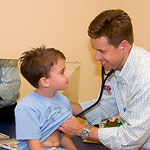By Dr. Allen Peabody
Pertussis or “whooping cough” is a contagious respiratory infection caused by the bacteria bordatella pertussis. Because of its subtle initial signs and varied presentation, it can be difficult to diagnose promptly. It can affect all age groups, but it can cause significant complications primarily with the newborn population.
The disease has three different phases of infection: catarrhal, paroxysmal, and convalescent. Infection starts with the catarrhal stage which lasts about 1-2 weeks and is marked by coughing, runny nose, and low grade fever. Pertussis is often not diagnosed in this stage because it looks like any other viral respiratory infection or common cold. After 1-2 weeks the cough typically worsens and evolves to the paroxysmal phase. For the next 2-6 weeks coughing fits or paroxysms dominate. The classic cough of pertussis is a dry staccato fit of coughing followed by an inspiratory “whoop” caused by forced inspiration. Vomiting can occur at the end of the coughing fit. The coughing worsens, peaks, and then begins to wane. Then the convalescent phase begins in which the cough begins to subside but can persist for several months. This is why in China pertussis is called the cough of a 100 days.
Complications of pertussis again primarily affect infants and can be quite severe. Pneumonia, apnea (a prolonged period of not breathing), cyanosis (color change due to lack of oxygen), poor feeding, weight loss, seizures, and death can occur.
Diagnosis of pertussis often is not made until later in the paroxysmal phase, and even then can be overlooked as most cases do not have all the classic signs of paroxysmal cough, whooping, and vomiting after coughing. This is especially true with infants. There are tests for pertussis but they are not very fast and can take days to weeks to return. If your doctor strongly suspects pertussis based on the presenting symptoms, they will likely empirically treat with antibiotics while waiting for the confirmatory lab tests. The treatment is more effective the earlier it is started in the illness. Most evidence shows no significant clinical improvements if the antibiotics are started after 21 days of symptoms. However, most clinicians will recommend treating after 21 days to decrease the risk of disease spread. It will also be important to prophylactically treat all those in close contact with infected patients.
The best way to prevent this disease is vaccination. Because routine immunization does not start until 2 months and young infants are at greatest risk, it is very important for all family members to be up to date with their vaccines (adults included!). Although vaccination is highly successful at preventing the disease, no vaccine is 100% effective and the immunity can wane with time. Be sure to ask your doctor if you and your children are up to date on their pertussis vaccine, especially if there is a new baby in the house.
The information and content on our website should not be used as a substitute for medical treatment or advice from your doctor.




